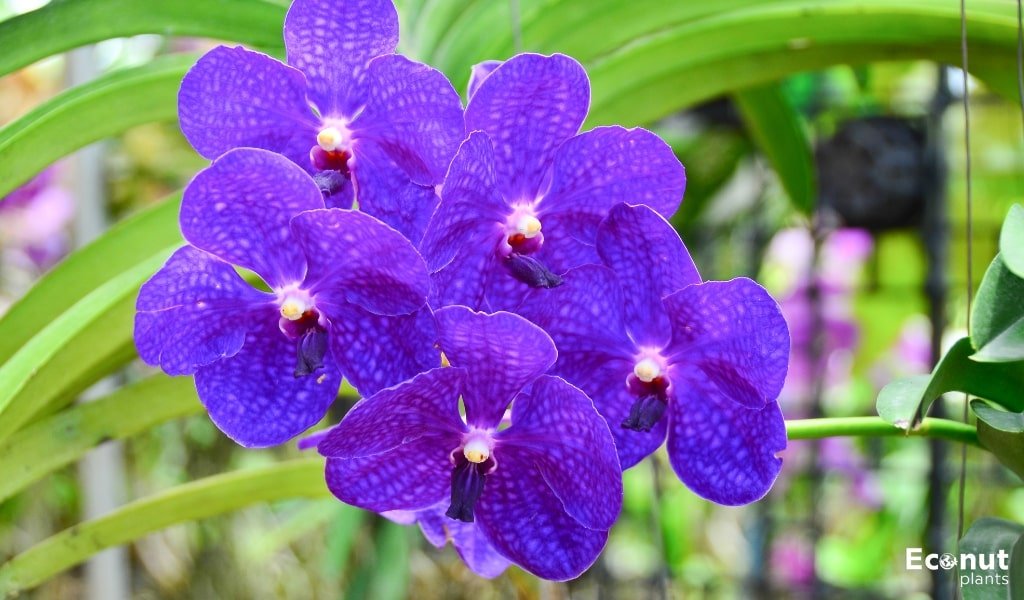Are you thinking about planting some purple orchids in your flower garden, but you’re not sure which kind to start with?
Choosing the ideal purple orchid might be challenging because they comes in many shades! Some of the best purple orchid varieties in this article!
1. Moonlit Grape
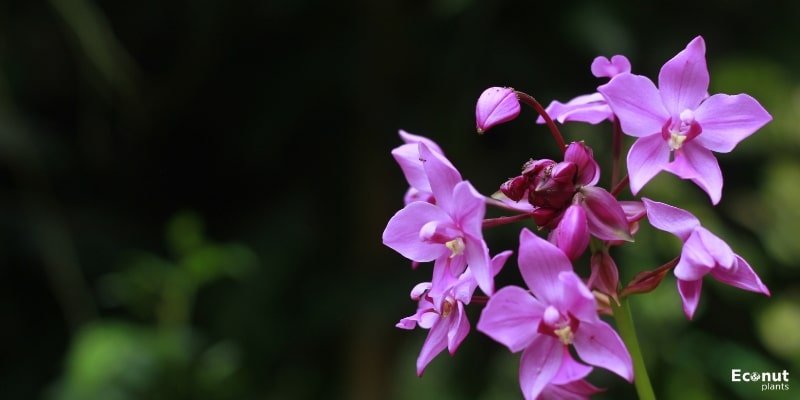 Scientific Name: Spathoglottis Sorbet ‘Moonlit Grape’
Scientific Name: Spathoglottis Sorbet ‘Moonlit Grape’
Bloom Time: Summer and fall
Sun Exposure: Full Sun to Light Shade
Plant Zone: 9-10
Moonlit Grape Ground Orchids, sometimes referred to as Sorbet Ground Orchids, are a tropical kind that do well in sunny indoor pots or as a flowering ground covering outdoor landscaping. The blooms have a continuous blooming season that lasts for up to six or seven weeks until they droop.
2. Mayumi
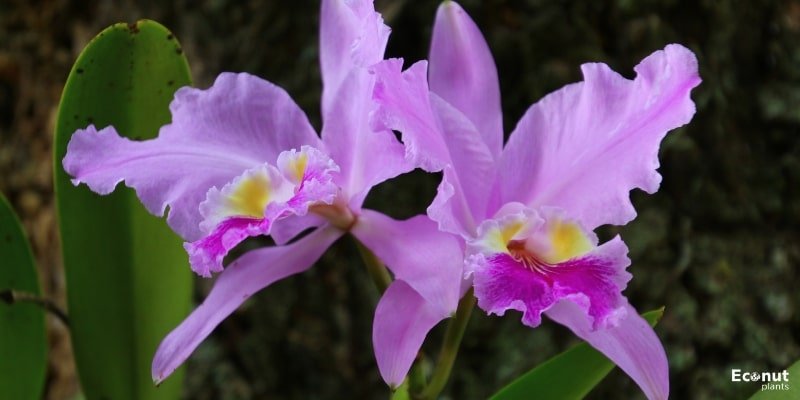 Scientific Name: Brassavola Nodosa x Cattleya Bowringiana
Scientific Name: Brassavola Nodosa x Cattleya Bowringiana
Bloom Time: Winter
Sun Exposure: Bright Indirect Light
Plant Zone: 10-12
The Brassanthe Maikai ‘Mayumi’ or Maikai ‘Myumi’ orchid is a hybrid of the Cattleya bowringiana and Brassavola nodosa orchids. It bears clusters of vivid lavender-pink flowers in the winter, with darker lip lines. The blossoms lose their colour and become fragrant at night and then during the next few days.
3. ‘Purple Stained Laelia’
 Bloom Time: Spring and Summer
Bloom Time: Spring and Summer
Sun Exposure: Partial Sun
Plant Zone: 10-12
The Brazilian orchid species called Cattleya purpurata, or purple-stained Laelia, has white flowers with vivid purple streaks around the borders. Purple-stained Laelia: The petals can be pale pink, dark amethyst purple, white, or occasionally have darker veining. Sometimes a flower’s inner whorls are darker than its outer whorls.
4. Phaius Orchids
 Bloom Time: Winter to Early spring
Bloom Time: Winter to Early spring
Sun Exposure: Partial Sun
Plant Zone: 9-12
Swamp orchids, or Phaius orchids, are a genus of flowering plants in the orchid family. The Ancient Greek word phaios, meaning “dusky” or “brown,” is where the name Phaius originates. This word alludes to the brownish hue of many of the blooms in this genus.
5. Pansy Orchid
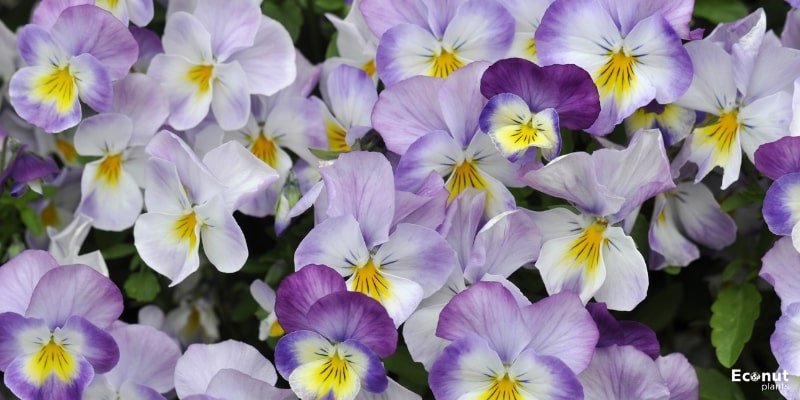 Bloom Time: Spring to autumn
Bloom Time: Spring to autumn
Sun Exposure: Partial
Plant Zone: 11-12 (USDA)
Large, flat flowers that mimic pansies are the hallmark of pansy orchids, which are epiphytic plants. They contain clustered pseudobulbs that store water and strap-shaped leaves that are often a pale green or grey-green colour.
The flowers of pansy orchids can endure for up to five weeks and are produced throughout the spring, summer, and occasionally the early fall. They are white, yellow, red, and purple, and have a hint of sweetness to their fragrance.
6. Cattleya Orchids
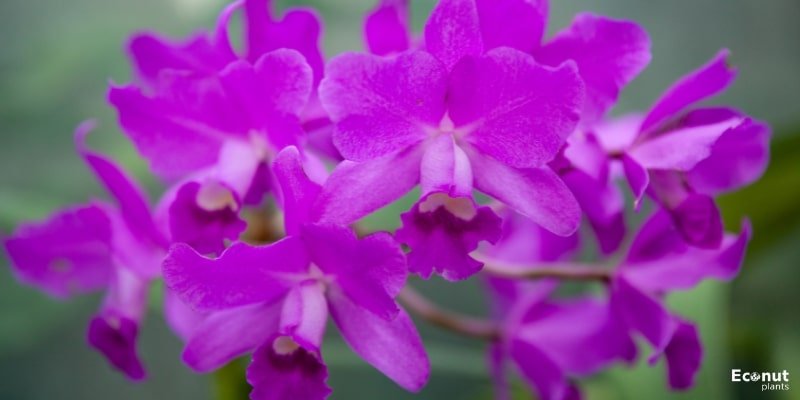 Bloom Time: Spring, summer, fall
Bloom Time: Spring, summer, fall
Sun Exposure: Partial
Plant Zone: 10–12 (USDA)
One type of purple orchid is the cattleya. These orchids feature a gullet that is an intense purple or deep magenta colour that is unique to the core of the flower. Light lavender to deep violet is the hue of cattleya plants and cut flowers that are sold for a fee.
7. Dendrobiums
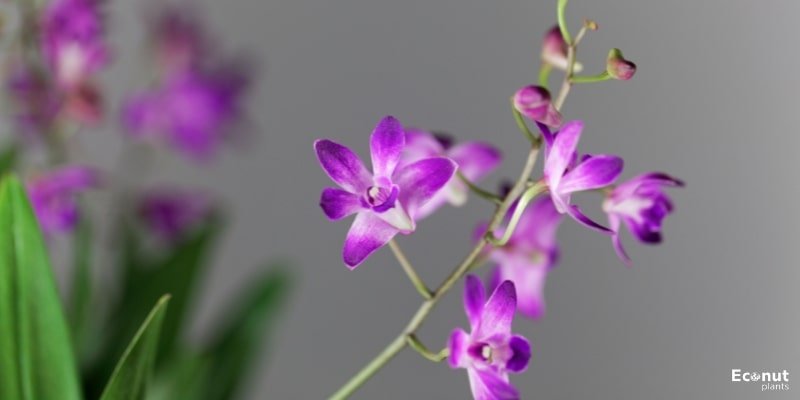 Bloom Time: Spring, summer, fall
Bloom Time: Spring, summer, fall
Sun Exposure: Partial
Plant Zone: 9–12 (USDA)
Dendrobium orchids grow multiple flowers on tall, arching stems. The blooms can be solidly coloured or have contrastingly coloured petals. Dendrobiums are seen in shades of light lavender, violet, and even a very dark blue-black purple, which is typically seen in deep purple-tipped white flowers or as complete purple petals.
8. Vanda Orchids
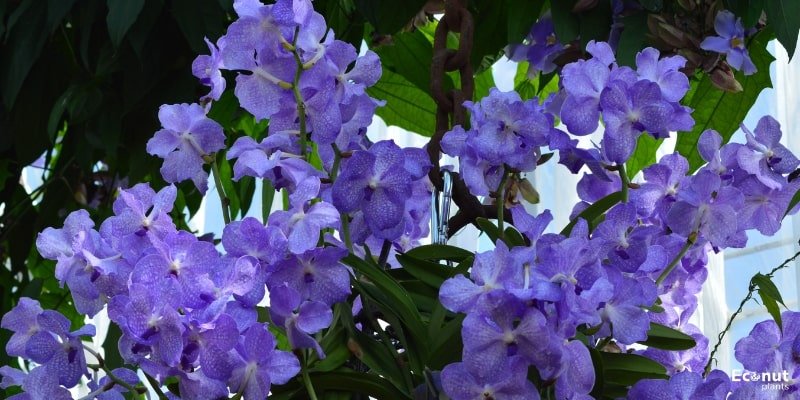 Scientific Name: Vanda
Scientific Name: Vanda
Bloom Time: Spring, summer, fall, winter
Sun Exposure: Part Sun
Plant Zone: 10-11
Vanda orchids are a genus of roughly 80 species that are prized for their fragrant and enduring blossoms and infinite colour variations.
These orchids are frequently seen growing in hanging baskets with plenty of air exposing their roots. Vanda orchids require a lot of light and high humidity, which makes them notoriously tough to grow, even if they bloom twice or three times a year.
9. Moth Orchids
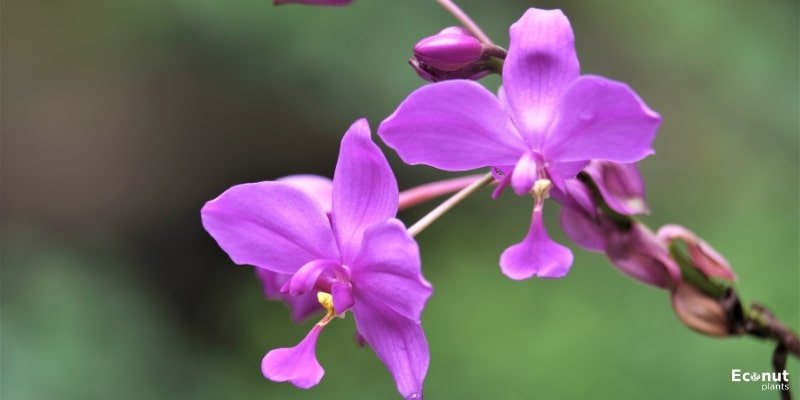 Scientific Name: Phalaenopsis
Scientific Name: Phalaenopsis
Bloom Time: Fall
Sun Exposure: Full Sun
Plant Zone: 10-12
One variety of orchid flowers that is frequently found in grocery stores and floral shops is the moth orchid. Their flowering colour range from a light lavender-pink to a deep violet with white speckles. They have a little warmer appearance with their pink and purple colour combination than the chilly, bluish purple touch of vanda orchids.
10. Zygopetalum Orchid
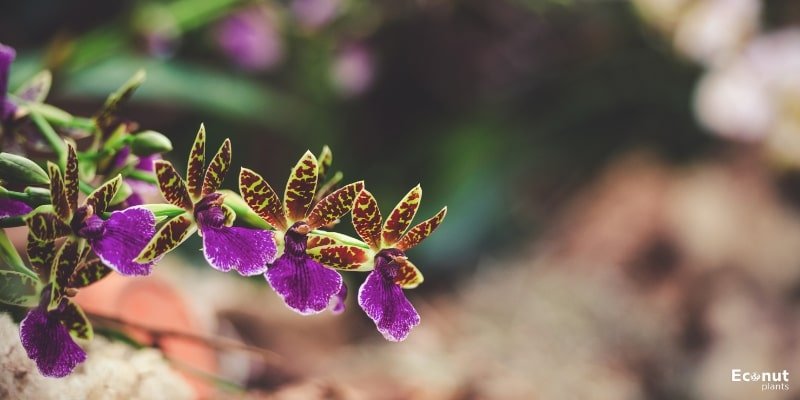 Scientific Name: Zygopetalum
Scientific Name: Zygopetalum
Bloom Time: Fall and spring
Sun Exposure: Full Sun
Plant Zone: 10-12
Healthy Zygopetalum orchids almost always yield fragrant blooms from fall to spring, with flavours ranging from chocolatey to spicy and peppery to flowery. When given the right care, these hardy orchids can bloom four times a year for three to four weeks.
Flowers with speckled and patterned petals and lips are two to four inches in size and come in tones of purple, burgundy, green, and white. Certain hybrids may have blue-hued flowers, which is an uncommon orchid colour.
11. Splash
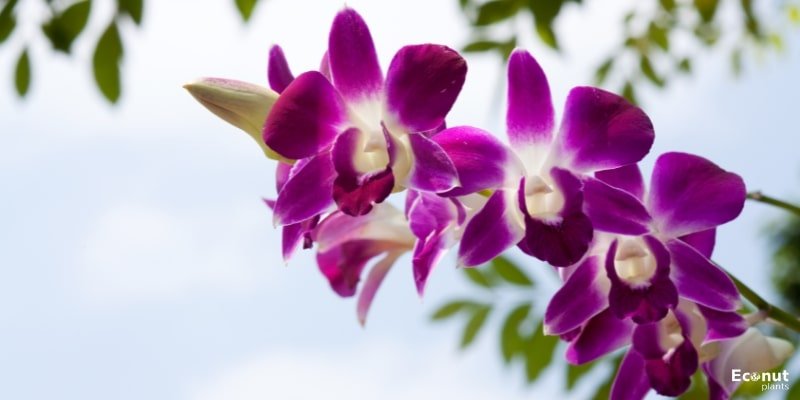 Scientific Name: Dendrobium Enobi Purple ‘Splash’
Scientific Name: Dendrobium Enobi Purple ‘Splash’
Bloom Time: Summer and fall
Sun Exposure: Part Sun, Bright Filtered Sun
Plant Zone: 9-11
This gorgeous dendrobium hybrid, which also combines white and purple, prefers intense yet filtered sunshine in large quantities. Selecting a good location for this plant is crucial because too little sunlight will lead to fewer blossoms.
When “Splash” is in bloom, which is from summer to fall, it likes a lot of water. Because this cultivar enjoys a lot of water, adequate drainage is essential.
With 1.5-inch flower stalks, this purple orchid is regarded as a little dendrobium. This cultivar gets its name from the vibrant purple splatters across the borders of the white petals and sepals.
12. Purple Stained Laelia
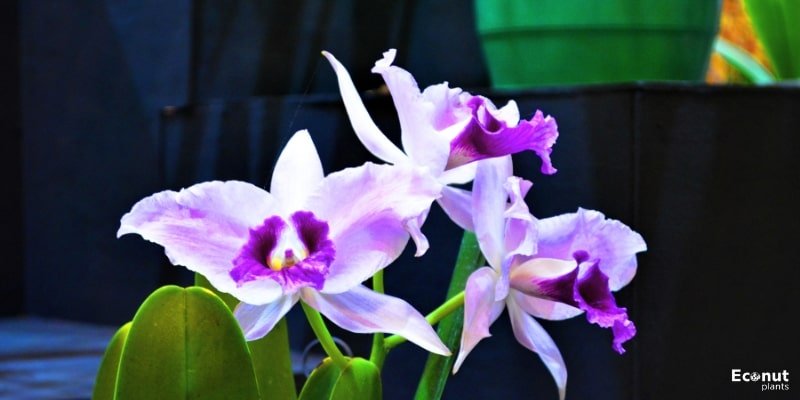 Scientific Name: Cattleya Purpurata var. Schusteriana
Scientific Name: Cattleya Purpurata var. Schusteriana
Bloom Time: Spring and summer
Sun Exposure: Part Sun
Plant Zone: 10-12
The lower petals of this orchid have a unique splash pattern that gives the impression of a painter’s brushstrokes due to the many shades of purple that are splashed over them.
13. Purple Reed Orchid
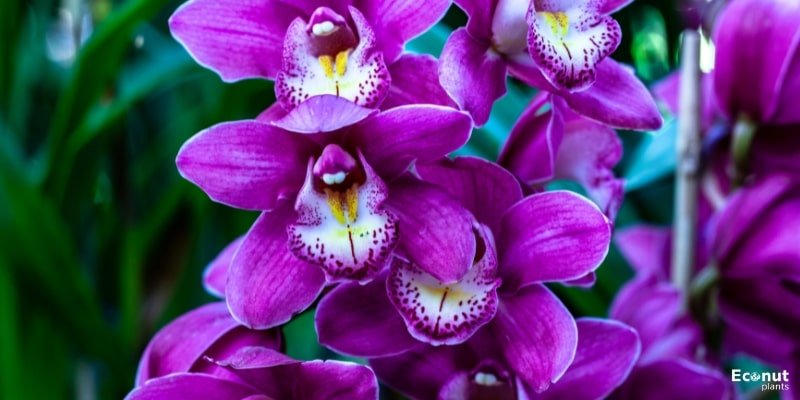 Scientific Name: Epidendrum x obrienianum purple
Scientific Name: Epidendrum x obrienianum purple
Bloom Time: Year Round
Sun Exposure: Part Sun
Plant Zone: 10-11
Purple orchids are frequently used as metaphors for aristocracy, prosperity, adoration, dignity, and respect. They can also be given to convey the passion and sincerity of a couple’s love, as well as as a symbol of respect.
In their native habitat, purple orchids can be found in forests or on cliffs. The early purple orchid is commonly found in areas like banks, hedgerows, old woods, and open grasslands that have non-acidic soils. The medium-height spike has pinkish-purple blooms.
14. Black Purple Cymbidium
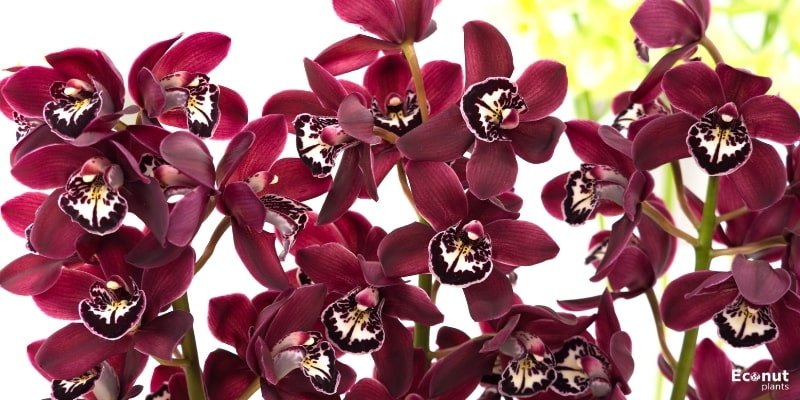 Scientific Name: Cymbidium ‘Atropurpureum’
Scientific Name: Cymbidium ‘Atropurpureum’
Bloom Time: Summer and Fall
Sun Exposure: Full Sun, Part Shade
Plant Zone: 10-12
Known for their boat-shaped flowers and grassy leaves, Cymbidium orchids are a symbol of morals and virtue. Giving or receiving a Cymbidium is considered an honorific, kind, and respectful gesture in Asia. In addition to being a symbol of respect, appreciation, or dignity, purple orchids are frequently connected to monarchy and wealth.
15. Lattice Orchids
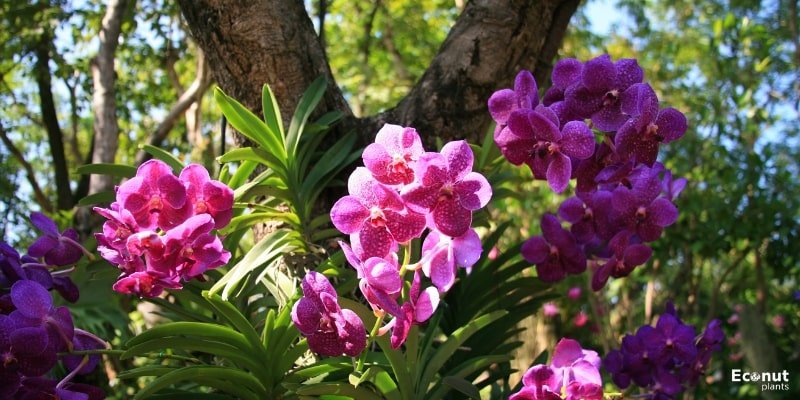 Scientific Name: Vanda tessellata
Scientific Name: Vanda tessellata
Bloom Time: Fall
Sun Exposure: Full Sun
Plant Zone: 10–11
The vivid colours of Vanda orchids are well known. The purple kinds are very eye-catching; some have an almost fluorescent brilliance.
16 Lady Slippers
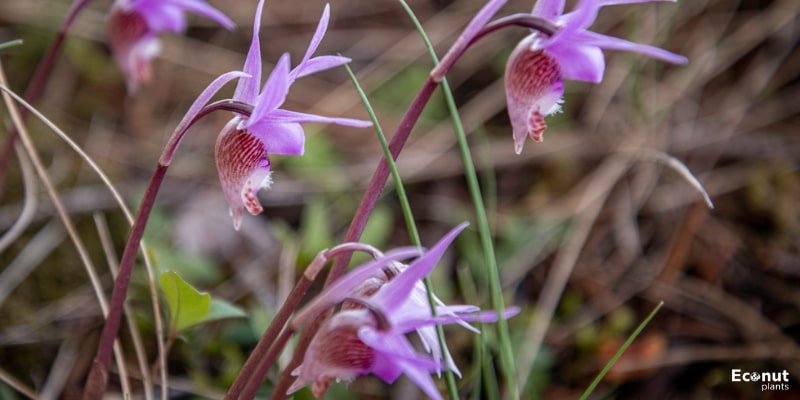 Scientific Name: Cypripedioideae
Scientific Name: Cypripedioideae
Bloom Time: Mid-winter and mid-summer
Sun Exposure: Part Shade
Plant Zone: 2-9
These orchids, which have a unique bloom on a long, hairy stem, offer an elegant, refined, and exotic appearance. The lower petal has a lighter colour in the center, and these blossoms have a deep reddish purple tint with a black-purple gullet.
17. Red Star
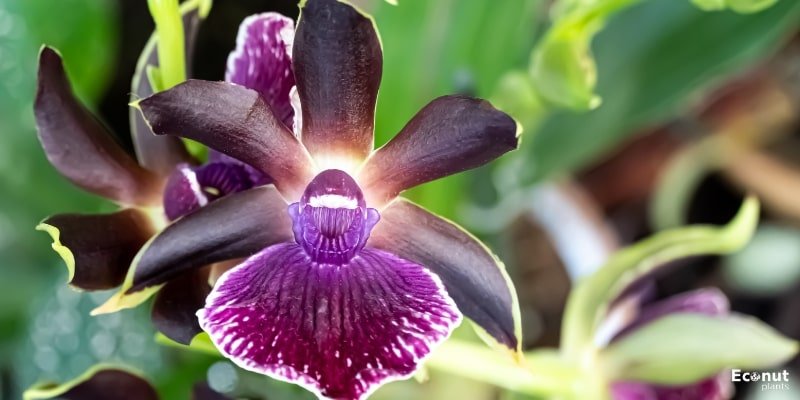 Scientific Name: Dendrobium ‘Red Star’
Scientific Name: Dendrobium ‘Red Star’
Bloom Time: Mid-winter and mid-summer
Sun Exposure: Part Sun
Plant Zone: 9-12
The name “Red Star” is misleading because this kind of dendrobium is distinctly purple. This fragrant and unusual orchid adds a lovely touch to floral arrangements. This flower’s petals and sepals are long and softly curved, with a white core that fades to a deep magenta colour.
The lip appears like a bullseye and is proportionately large. More of the deeper purple surrounds a ring of white that has a deeply pigmented core.
In general, dendrobiums are easy to maintain and make excellent first orchids. They require a moderate level of moisture; however, they become dry in between waterings. They require a good amount of sunshine in order to develop their bloom stalks. Their flowers remain for a very long time, and they can bloom twice a year.
18. Honohono
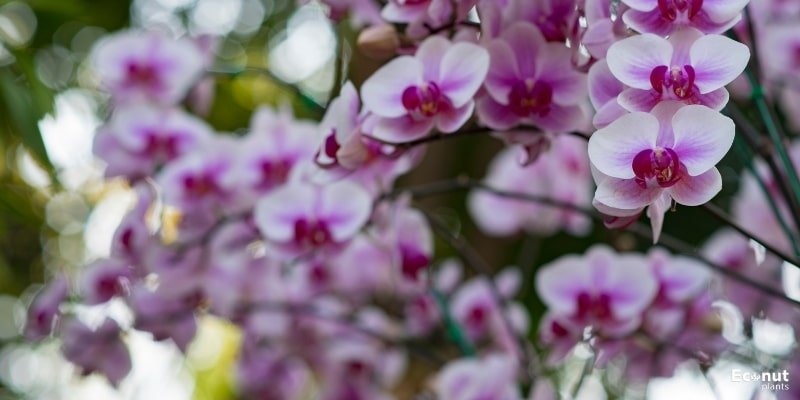 Scientific Name: Dendrobium anosmum ‘Honohono’
Scientific Name: Dendrobium anosmum ‘Honohono’
Bloom Time: Winter and Spring
Sun Exposure: Part sun
Originally from tropical monsoon conditions, the honohono orchid (Dendrobium anosmum). The wet season is when its leaves grow, while the dry season is when its blossoms show. While flower stalks are only 1 to 3 feet long under cultivation, leaf and flower stems trail from the plant and can grow up to 9 feet in the wild.
Lilacs and hyacinths are the dominant scents of flowers that blossom in shades of purple, pink, or white. You can smell the perfume of the honohono orchid in the Franklin Park Conservatory and Botanical Gardens.

